Nasu dengaku – miso glazed aubergine

Nasu dengaku is a simple dish to prepare, aubergine topped with a sweet, salty, nutty glaze. It will make a good side dish and I like having it as a snack for lunch.
None of the nasu dengaku recipes I came across on the net mentioned the importance of the skin. Aubergine skin when baked, grilled or fried can become leathery but in this dish there must be some skin in order for the aubergine to retain its shape when cooked.
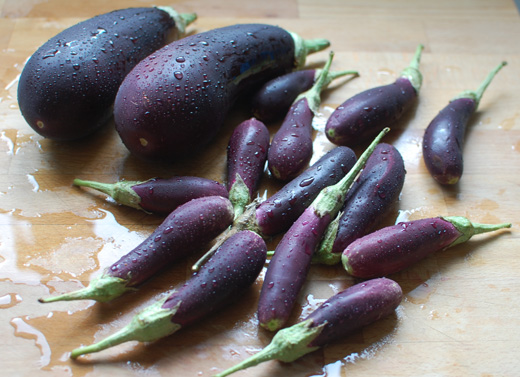
The answer to resolving the aubergine skin came from A Taste of Japan by Lesley Downer (now out of print). A simple book with traditional recipes. In their recipe for aubergine with miso they strip the skin into a stripe pattern.
Cutting the aubergine into a stripe effect allows for easier biting into the aubergine but with enough skin to hold the shape when cooked.
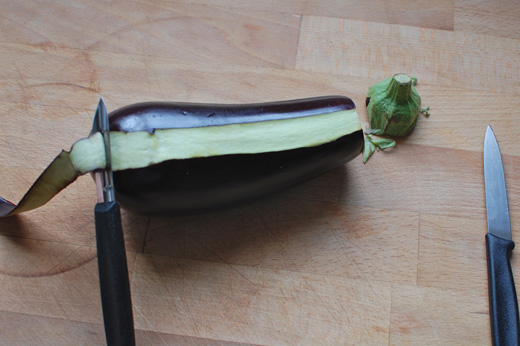
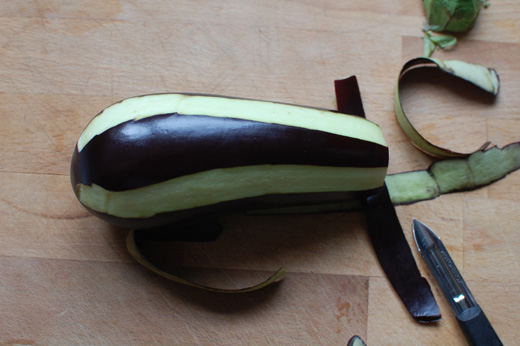
I tried the aubergine cut into thick round slices and lengthways and concluded that although lengthways they look very attractive I prefer cut into thick slices because there is a better ratio of glaze to flesh.
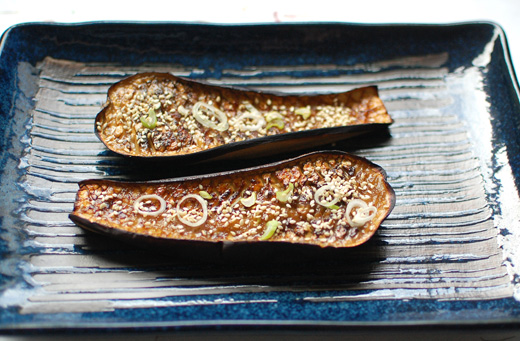
Do not to bother with baby aubergines at all. By the time they are cooked they have a large ratio of skin to flesh which is not pleasant to eat.

Choose a small to medium size aubergine. It’s really important to score the flesh before cooking, because when they cook the cut opens up and the glaze can seep down the cracks, more of the flesh is penetrated with flavour.
I fried and baked the aubergine and prefer to bake them for this recipe. Baking was easier. Frying lets the flesh absorb fat which makes the result taste a little greasy.
Before going into the oven brushed the surface with some oil. Bake in hot oven until completely soft in the middle, 25-30mins depending on size.
Brushed the glaze on. Put the aubergines back in the oven for a couple of minutes for the glaze to bubble. Best eaten while warm.

If putting the aubergine under the grill the edges burn easily.
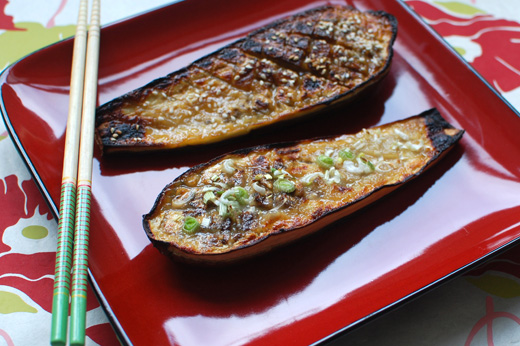
Miso
The ratio of miso to other ingredients varies with recipes. Some recipes have larger ratio of miso to mirin and sake, some have large amounts of sugar. Others are equal amounts of miso to the rest of ingredients.
I like using white miso because it’s the lightest miso. Red miso is also used but it’s stronger and saltier than the white. White miso varies on saltiness, it will depend on the brand.
I liked adding freshly grated ginger at the very end and top with thin slices of spring onion. They added a zingyness and freshness which cut through the richness of the glaze really well.
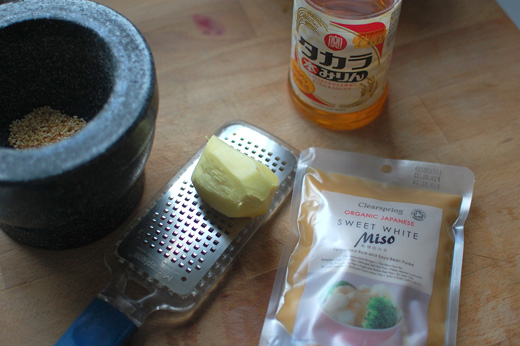

Some recipes start by reducing the mirin and sake first, and then adding the miso. Others reduce the miso with the mirin and sake.
I tried one recipe adding toasted sesame seeds ground into powder but I found it too cloggy and thick in the mouth.
Omitting sake
I tried using just mirin without sake. I noticed such small difference without the sake that I would recommend using only mirin if you can not buy sake. The sake made the glaze have a slight alcoholic note, even after reduction.
After trying many different variations on the glaze I settled on one which boiled all the ingredients together until a caramel consistency and colour. Not too thick, not too concentrated.
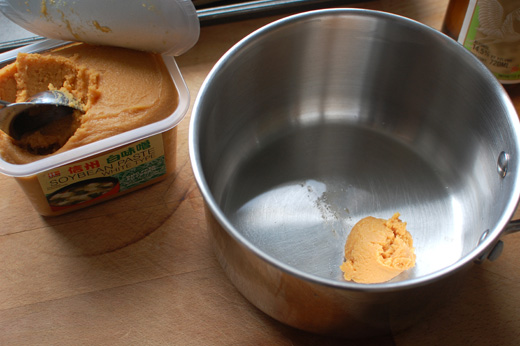

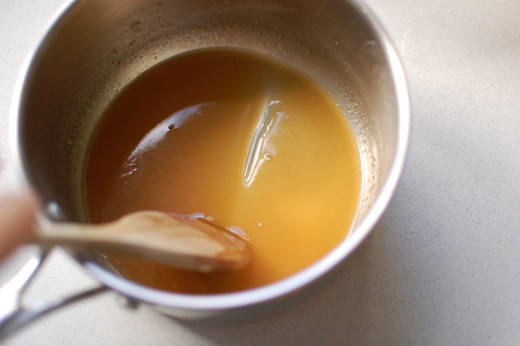
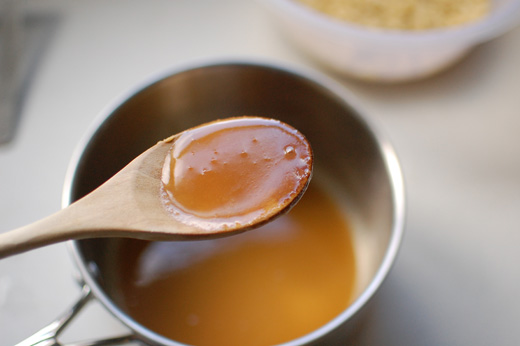
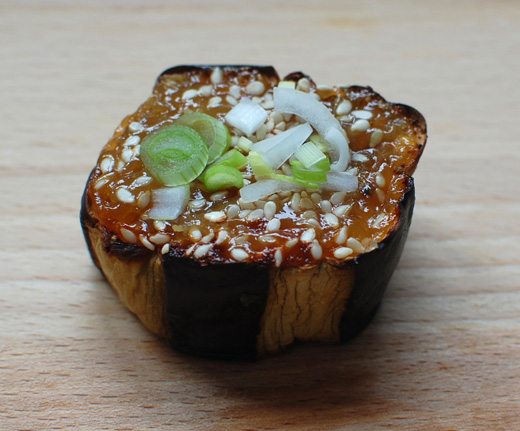
- 2 small to medium size aubergines
- 1 tablespoon of white miso
- 2 tablespoons mirin (sweet cooking wine)
- 2 tablespoons sake (sake is more like beer than wine in its making process) can replace it with all mirin
- 1 – 1½ teaspoon sugar
- ½ – 1 teaspoon freshly grated ginger
- 1 teaspoon finely chopped spring onion (scallion)
- ½ teaspoon of toasted sesame seeds
- Pre-heat oven to moderate 180˚C
- Start by peeling strips of the aubergine skin leaving the aubergine with a stripe affect. Cut the aubergine into thick round slices or slice it lengthways. Score criss-cross marks on the flesh of the aubergine and place them on a baking sheet. Brush the top of the aubergine with some oil and place them in the pre-heated oven to bake all the way through. For slices check after 25 minutes for the aubergine halves it can take 30-35 minutes.
- To prepare the glaze add the miso, mirin, sake and sugar to a small pan bring it to the boil and simmer for a minute or so until the miso has melted and thicken. Keep whisking and the miso will melt. Add the ginger.
- When the aubergines are soft and cooked through brush generously the glaze over them, serve them like this or put them back in the oven for a couple of minutes to bubble the glaze. Sprinkle the spring onions and toasted sesame seeds and serve warm.

